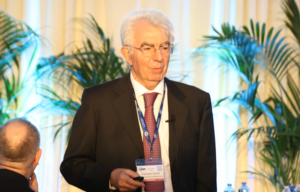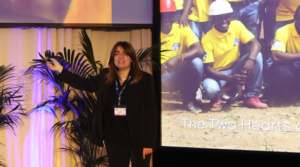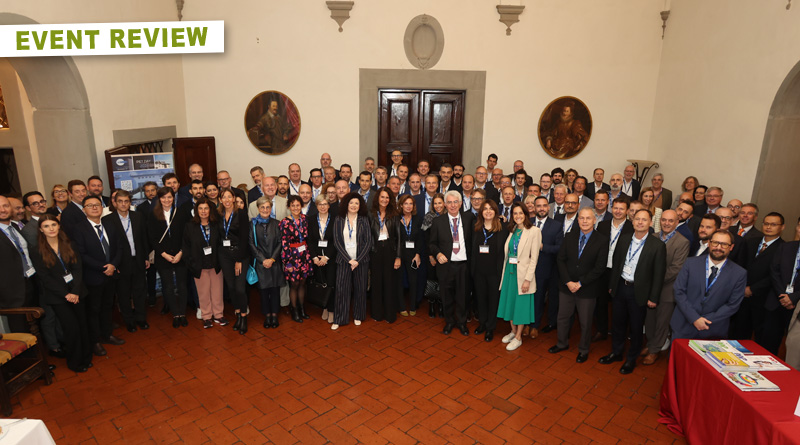“We need more collection, education and fines”
PET Day 2024
Rain or shine, we came back to Artimino, Florence, Italy, for the 22nd PET Day. This 2024 edition was unfortunately, for the very first time, under a steady rain throughout the event, but that did not discourage the exclusive audience to be present at the iconic Villa Medicea. The event was hosted by G.S.I. Global Service International srl, Italy, and its entire team welcomed customers and suppliers, top managers and purchasers, polyesters experts and economists at the historical venue.
Mr Francesco Zanchi, founder and CEO of GSI, opened the PET Day surrounded by his team introducing the new members of his international staff. The global presence of GSI is getting wider and expanding its presence in all continents, excluding only Oceania and Antarctica (for now…). The company has been on the market for more than 30 years, and it is recognised as one of the top leading player and reputable partner in the raw materials world, covering polyesters and polyolefins.

The event commenced with a thought-provoking lecture presented by Paul Hodges, of New Normal Consulting, a familiar presence in the latest PET Days. He addressed the critical implications of the ageing global population, particularly in the West, where the former wealth creators, known now as the perennials (over 55 y/o) are becoming too many in comparison with the current younger population: unfortunately, this imbalance is failing to support a new cycle of new economic growth. This demographic shift poses significant challenges to the world economies and also to PET markets. These are not happy times; life is not stable anymore. All markets will change greatly in the next few years, mainly between 2027 and 2030. The EV car evolution is one example: in China already 50% of the cars are now electric. In the chemical sector, there is still an incredible number of new investments creating an even bigger overcapacity. Oil and petrochemicals will suffer: refineries will shut 30% of their capacity by 2030. Mr Hodges stated that we need some reinvention to have growth opportunities: more service orientation, provide solutions more than products, mostly addressed towards mobility, water, food, health, defence and conservation.

Mr Hemant Sharma of Reliance, India, echoed the great volatility that the industry must face and must adapt to. The geopolitical tensions of the last 12 months, the rising freight costs, inflation and interest rates: he hopes the worst is behind us. At least some signals indicate that. Mr Sharma foresees oil moving down next year. Polyester producers are suffering and 2025 will be even more challenging considering the increase in capacity worldwide: “Just look at PTA where its increase of output between 2020 and 2024 is double the amount of the increase in demand. It is necessary to work on recycling and Reliance successfully is greatly committed to generate more and more awareness on recycling particularly in India,” he summarised.

Philippe De Baere, managing partner of Van Bael & Bellis, Belgium, took the microphone with an overview on PET in the EU trade context, explaining how today EU trade policies are more and more linked to its environmental stance. “In any case EU trade defense measures, after having hit Chinese PET, risk now to turn towards PET of Vietnamese origin, the import of which has inevitably strongly increased. There is a possibility that the EU will use Anti-Circumvention instrument to implement new protection measures, usually a harsher tool than the usual anti-dumping.”

Francesco Zanchi, GSI, started illustrating the general overcapacity in China for all polyester-related materials, from PTA to PET. “The point is that, worldwide, the demand for PET in 2025 will be dropping but capacity will keep increasing. Output is expected at around 44 million tonnes against a demand lower than 30 million. In China alone the surplus of PET nearly doubled from 2023 to 2024 (5 to 9 million tonnes) and will increase still. Eventually it is important always to watch closely what China is doing in polyesters as they have 48% of the world capacity and 75% of the world trade. In Europe, demand for virgin is getting lower, and it is moving towards rPET, whose output is increasing in line with the demand. Our continent though needs imports of recycled materials, less rules and even more controls are needed to support a quicker transition but in accordance with existing rules.”
Then Zanchi made an exclusive and pivotal announcement regarding the initiation of the PET futures market in China, at the ZCE (Zhengzhou Commodity Exchange). This is an important instrument for sellers and buyers, which will allow, once accessible also to foreign operators, to fix longer term contracts on a global scale. In conclusion, the GSI founder and CEO indicated in oil rates and freight costs the two main things which will have influence on PET and raw materials prices in 2025: “Oil will maybe increase towards the 100 $ mark, but in any case, will not go below 75 $; freights will move down and possibly up again due to powerful cartels in the sector.”

In the final presentation of the morning Chiara Zanchi, GSI General Manager and President of St. Lawrence Foundation, explained how the foundation is really the second heart of GSI, beating to support the community of Makeni in Sierra Leone, one of the poorest countries in Africa. From the creation of the Unimak (University of Makeni) to the courses in agriscience, to the creation of an actual company, a poultry farm (SBD) with 70 workers, raising chickens and producing eggs and feeds for the local people and farmers. The development over the past ten years has been enormous and rewarding for the Zanchi family and for all the people who offered their support to the cause. The help offered to the people in Sierra Leone to have better food and education is however just at the beginning, but the course is set.
The afternoon session was opened with Prof Chris DeArmitt, connected on video from the US. He illustrated his studies reported in his (freely available) book “The Plastic Paradox”. After checking a huge number of scientific studies on plastic materials and based on his experience in polymer science, Chris gave a shocking picture of the wide misinformation on plastics. These just represent less than 1% of the materials used in the world, they are surely 13% of household waste, but just 0.3% of the ALL the waste we create! In his video “The Great Plastic Distraction” he shows how many lies on plastics have been spread around in the last years for various reason paving way to the use of other materials which are more polluting and generating bigger amounts of CO2, so contradicting the policies the mainstream policies want to implement.
Mr Antonio Protopapa of Corepla introduced what his consortium is doing, in Italy, for improving circularity and sustainability. “The country has good rates in collection but must do better to reach the 90% target. Better work must be done too in separating all plastics, more accurate sorting and recycling need to be reached to have improve the quality of available recycled raw materials.”
Then Zanchi opened up the three rounds of Round Table among operators of various sectors to comment on the presentation from Chris DeArmitt. In the first round, Sharma, Protopapa and De Baere agreed that it is definitely necessary to separate scientific information from all the fake news, particularly on plastic packaging. The intervention of Werner Bosman (EU Commission) from Brussels, added up some spice as he showed doubts on the actual validity of some information offered in DeArmitt’s video. In saying it is necessary not to take any step back on plastics, he considered dangerous avoiding discussing the issues that these materials create. “The American professor though is very firm in giving his study the greatest validity, confirming first the full independence of it and then his purely scientific approach in the collection of the data which were found in a long list of strictly scientific papers, without any preconceptions.”
In the second round of interventions, J.L. Banos (CAIBA, Spain), fully agreed with DeArmitt and admitted there are big problems in misleading communications on plastic in general. “The main problem is the public opinion which has been influenced in the past by a lot of intentional or unintentional false claims.” Lucas Aquino and Larisa D’Otaviano (Valgroup, Brazil) think that education is fundamental: “It is necessary to properly share correct information on PET and all similar materials starting from schools, and they are trying to do so in Brazil.” Slawomir Rusocki (WIP Group, Poland) agreed that fake news must be fought: “In Poland they are spread also on television. Fighting mainstream media it is hard.” Dirk De Cuyper (Resilux, Belgium) is aware of the study from DeArmitt and would like it to be offered to greater audiences, and to convince consumers eventually. Zanchi immediately took the opportunity to stimulate the managers, and all the operators present in the PET Day room, to act and do whatever in their possibility to get the message through to people, politicians, journalists, to the broadest reachable audience, and to find ways to explain properly the truth on plastics.
In the third round, Coert Michielsen (Refresco, Netherlands) was definitely interested in acting according to Zanchi suggestion. Enrico Arciuli (Frana Polifibre, Italy) is fully in line with the initiative, but likes to spend a word to remind that recycling is not just for bottlers or the packaging industry, but a major role in using up and recycling all polyester wastes has to be assigned to the fibre and the textile industry. Ferrarelle (Italy) stated that they already try their best to communicate the recyclability of PET, illustrating to their customers the importance of proper collection.
Eventually littering and mismanaged waste are the problems to solve they are caused by uneducated people, not by the PET producers. “We need more collection, education and fines,” said Zanchi convincingly. “Scientifically these measures will work. All European producers must convey the message to the politicians and the public to stop blaming a material which is greener and more precious than what anyone, outside of this business, unfortunately, has been brought to think.”

